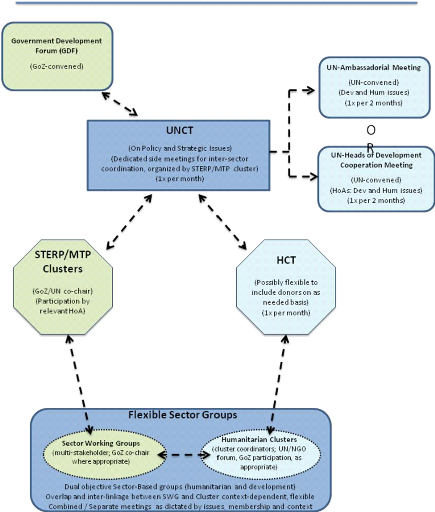2.7 Monitoring, evaluation
Humanitarian and Early Recovery partners in Zimbabwe are
continuously monitoring their actions and activities on several different
levels:
As steward of the humanitarian reform and recovery process,
partners are constantly involved in the functioning of the cluster approach in
Zimbabwe through participation in cluster meetings, field assessment mission,
and interacting with line ministries.
Humanitarian Country Team meet once a months in order to
formulate recommendations to both cluster leads and the Humanitarian
Coordinator, who has the main responsibility for humanitarian coordination in
the country, for improving cluster functioning wherever necessary.
Partners conduct monitoring and evaluation of their
performance in relation to their work plans and programmes.
2.8 Cross-Cutting issues
Ensuring the smooth transition from relief to recovery and
long term development in both post-conflict and post-disaster situations is a
core part of OCHA and UNDP?s mandate. This objective is also expressed on the
General Assembly Resolution 46/182, but also a corporate priority in OCHA and
UNDP?s Strategic Framework and . The role of OCHA and UNDP in transition
contexts is mainly to support recovery and development actors in:
1. Ensuring that residual or potentially new humanitarian
needs continue to be met, while supporting recovery and development actors in
assessing longer-term needs and vulnerabilities and jump-starting some early
recovery activities.
2. Promoting overall operational coherence and financial support
across actors and activities while phasing down humanitarian operations.
Questions and concerns regarding the gender balance and cross
-cultural responsiveness are both considered by humaniratian and early recovery
stakeholders in planning of activities and outcomes as well as in needs
assessments and responses.
Humanitarian and early recovery partners are also playing a
vital part in the mainstreaming of gender and HIV/AIDS in the various
interventions, Contingency Planning, CAP, ZUNDAF, assessments and training
activities to ensure that the policies on these issues are fully applied,
monitored and evaluated.
2.9 Continuum strategy (Linking Relief, Rehabilitation
and Development)
Currently, Humanitarian and early recovery partners operating
in Zimbabwe are working towards consolidating gains achieved in humanitarian
coordination. The introduction of the cluster approach in 2008 and continued
rolling out of clusters at district and provincial level, an increased
cooperation between the international humanitarian community and the Government
of Zimbabwe are also contributing to an improvement in coordination between key
actors.
The Government of Zimbabwe and the Humanitarian Country
Team(HCT)s are also working towards strengthening relationships with a wider
group of operational partners, and other relevant actors to advance
humanitarian and early recovery action. This is being achieved through
enhancing engagement and partnership with counterparts in the Government, NGOs,
regional bodies and donors, in support of humanitarian and early recovery
actions in order to allow for efficient response and transparent coordination
with participation of all key stakeholders.
To ensure an efficient response and fully de-link the
humanitarian and early recovery responses from the political motivation,
response planning is based on rigorous and jointly assessed situation analysis.
With increased information management capacities, the humanitarian and early
recovery partners are focused on tailoring more user oriented information
products to better support inclusive assessment, planning and needs based
response.
In addition, humanitarian and early recovery partners are
ensuring a more systematic coordination of the common programme cycle. With the
roll-out of the cluster approach in 2008, the improvement of the ERF and CERF
and gradually more inclusive CAP process, there is increased engagement in the
development of the common humanitarian action and early recovery plan. It
remains a priority to ensure that effective coordination and response
mechanisms support the Humanitarian Country Team and clusters at national and
provincial level for joint assessments and analysis, resource mobilization and
humanitarian response.
Meanwhile, The UNCT hosted a retreat on coordination
arrangements in Zimbabwe on 25 January 2010. The retreat resulted in a clear
understanding of existing coordination mechanisms and structures of the
Government of Zimbabwe (GoZ) as well as Donor Partners and the harmonization of
UN coordination structures for humanitarian and development assistance to
Zimbabwe appropriately linked to national structures and mechanisms as
follow17:
17 Office of RC/HC in Zimbabwe, Report of UNCT Retreat
of January 25th 2010


Key Highlights
United Nations Country Team(UNCT)
1. Responsible for strategic and policy issues
2. Responsible for ensuring cross-sector collaboration
3. Monthly meetings would have dedicated time for side meetings
based on STERP/MTP clusters; to ensure cross-sector collaboration
Meetings Convened by UN with Donors
1. One monthly meeting with Donors convened by UN
2. Every other month: Ambassadorial level, focusing on full
range of humanitarian and development issues
3. Every other month: UNCT and Heads of Donor Technical
Cooperation, focusing on full range of humanitarian and development issues
4. STERP/MTP Clusters and HCT
5. Alignment with STERP/MTP achieved through participation of
HoAs from lead UN agencies in STERP/MTP clusters (convened by GoZ, possibly
co-chaired by UN agency)
6. STERP/MTP clusters give policy direction to Sector Working
Groups
7. HCT gives policy direction for humanitarian work in each
sector (through humanitarian cluster coordinators) Dual-Functioning
Sector Groups
1. Sector-based groups that look at full range of issues
(humanitarian, early recovery, development)
2. Lead UN agencies named for each sector to ensure coordination
across H/D divide within sector (existing mechanisms may be sufficient,
depending on sector)
3. Depending on context, sector groups may have joint forums
and/or separate humanitarian and development forums, or some combination (based
on stakeholders, issues, context)
4. Where appropriate, look for opportunities to bring full range
of issues together to eliminate duplicate forums
5. Where necessary, maintain separate space for humanitarian
actors (as defined by cluster leads) Sector Groups can evolve with
context:
1. As appropriate, GoZ can chair or co-chair
2. As appropriate, humanitarian community can maintain separate
forum for specific issues
3. As appropriate, Sector Working Groups can serve as MDTF
sector groups
4. Chair, agenda-setting, and decision-making can be different
depending on the issue, even in the same forum
5. Sector-Specific Scenarios
The sector-specific scenarios
| 


